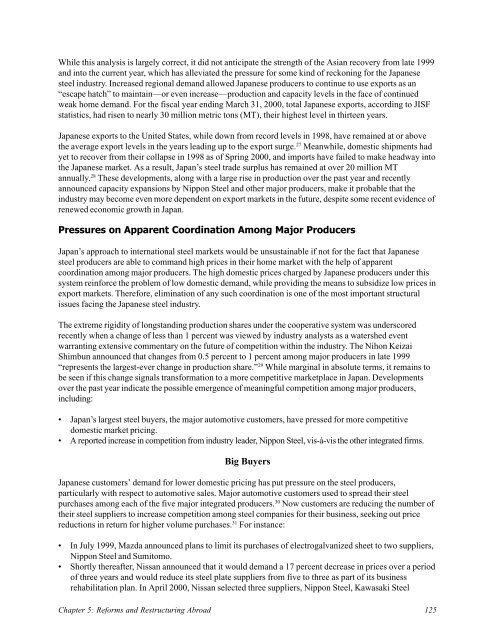Global Steel Trade; Structural Problems and Future Solutions
Global Steel Trade; Structural Problems and Future Solutions
Global Steel Trade; Structural Problems and Future Solutions
Create successful ePaper yourself
Turn your PDF publications into a flip-book with our unique Google optimized e-Paper software.
While this analysis is largely correct, it did not anticipate the strength of the Asian recovery from late 1999<br />
<strong>and</strong> into the current year, which has alleviated the pressure for some kind of reckoning for the Japanese<br />
steel industry. Increased regional dem<strong>and</strong> allowed Japanese producers to continue to use exports as an<br />
“escape hatch” to maintain—or even increase—production <strong>and</strong> capacity levels in the face of continued<br />
weak home dem<strong>and</strong>. For the fiscal year ending March 31, 2000, total Japanese exports, according to JISF<br />
statistics, had risen to nearly 30 million metric tons (MT), their highest level in thirteen years.<br />
Japanese exports to the United States, while down from record levels in 1998, have remained at or above<br />
the average export levels in the years leading up to the export surge. 27 Meanwhile, domestic shipments had<br />
yet to recover from their collapse in 1998 as of Spring 2000, <strong>and</strong> imports have failed to make headway into<br />
the Japanese market. As a result, Japan’s steel trade surplus has remained at over 20 million MT<br />
annually. 28 These developments, along with a large rise in production over the past year <strong>and</strong> recently<br />
announced capacity expansions by Nippon <strong>Steel</strong> <strong>and</strong> other major producers, make it probable that the<br />
industry may become even more dependent on export markets in the future, despite some recent evidence of<br />
renewed economic growth in Japan.<br />
Pressures on Apparent Coordination Among Major Producers<br />
Japan’s approach to international steel markets would be unsustainable if not for the fact that Japanese<br />
steel producers are able to comm<strong>and</strong> high prices in their home market with the help of apparent<br />
coordination among major producers. The high domestic prices charged by Japanese producers under this<br />
system reinforce the problem of low domestic dem<strong>and</strong>, while providing the means to subsidize low prices in<br />
export markets. Therefore, elimination of any such coordination is one of the most important structural<br />
issues facing the Japanese steel industry.<br />
The extreme rigidity of longst<strong>and</strong>ing production shares under the cooperative system was underscored<br />
recently when a change of less than 1 percent was viewed by industry analysts as a watershed event<br />
warranting extensive commentary on the future of competition within the industry. The Nihon Keizai<br />
Shimbun announced that changes from 0.5 percent to 1 percent among major producers in late 1999<br />
“represents the largest-ever change in production share.” 29 While marginal in absolute terms, it remains to<br />
be seen if this change signals transformation to a more competitive marketplace in Japan. Developments<br />
over the past year indicate the possible emergence of meaningful competition among major producers,<br />
including:<br />
• Japan’s largest steel buyers, the major automotive customers, have pressed for more competitive<br />
domestic market pricing.<br />
• A reported increase in competition from industry leader, Nippon <strong>Steel</strong>, vis-á-vis the other integrated firms.<br />
Big Buyers<br />
Japanese customers’ dem<strong>and</strong> for lower domestic pricing has put pressure on the steel producers,<br />
particularly with respect to automotive sales. Major automotive customers used to spread their steel<br />
purchases among each of the five major integrated producers. 30 Now customers are reducing the number of<br />
their steel suppliers to increase competition among steel companies for their business, seeking out price<br />
reductions in return for higher volume purchases. 31 For instance:<br />
• In July 1999, Mazda announced plans to limit its purchases of electrogalvanized sheet to two suppliers,<br />
Nippon <strong>Steel</strong> <strong>and</strong> Sumitomo.<br />
• Shortly thereafter, Nissan announced that it would dem<strong>and</strong> a 17 percent decrease in prices over a period<br />
of three years <strong>and</strong> would reduce its steel plate suppliers from five to three as part of its business<br />
rehabilitation plan. In April 2000, Nissan selected three suppliers, Nippon <strong>Steel</strong>, Kawasaki <strong>Steel</strong><br />
Chapter 5: Reforms <strong>and</strong> Restructuring Abroad 125
















